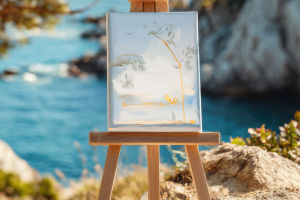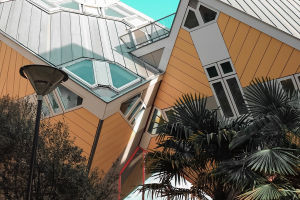Van Gogh’s Art That Lives On
Lykkers, the artistic brilliance of Vincent Van Gogh is celebrated across the globe. His signature post-impressionist style, characterized by bold brushes and vibrant hues, makes each artwork a visual feast.
While during his lifetime, Van Gogh faced immense struggles and only sold a few pieces, today, he stands as a giant in the art world.
Original works of this talented artist now fetch astronomical sums, with pieces like the Portrait du Docteur Gachet selling for over $82 million. Many of his masterpieces are proudly displayed in museums, with a significant collection residing in the Van Gogh Museum in Amsterdam.
Starry Night's Cry
Painted from his room at the Saint-Paul asylum (1889), The Starry Night (MoMA, New York) is pure cosmic drama. Thick impasto swirls churn the sky – not serene, but alive. A monstrous cypress tree claws upwards, linking the sleepy village below to the exploding heavens. The village? Likely a memory of Saint-Rémy.
This isn't just a view; it's raw emotion painted in ultramarine and chrome yellow. His turbulent mind found voice in every turbulent brushes.
Sunflowers' Golden Hymn
Arles, 1888. Van Gogh dreamed of an Artist's Colony. To welcome Paul Gauguin, he painted radiant Sunflowers (multiple versions, Van Gogh Museum, Amsterdam; National Gallery, London). More than décor, they were symbols of gratitude and light. Using layered lemon yellows and ochres, he captured blooms in various states – fresh, wilting, defiant.
The thick paint creates texture you can feel. Gauguin admired one so much, Van Gogh gifted it. These flowers blaze with hope.
Self-Portrait's Gaze
Van Gogh painted over 35 self-portraits, a lifeline when models were scarce or funds low. The 1889 version (Musée d'Orsay, Paris) is iconic. His piercing green-blue eyes lock onto yours. Fiery red hair and beard frame a face etched with intensity. Dressed in his painter's smock, it’s stripped bare – no pretense. The swirling background mirrors his inner turbulence. This is raw vulnerability: the artist confronting himself, and us.
Potato Eaters' Truth
Before the vibrant colors, came The Potato Eaters (1885, Van Gogh Museum). In earthy umber and sienna, it depicts peasant life in Nuenen. Five figures share a meagre meal under a single lamp. Van Gogh used stark chiaroscuro – deep shadows against lamplight – to sculpt their worn hands and faces. He wanted to show their dignity, their connection to the land they worked. It's gritty, real, a profound statement of empathy.
Wheatfield's Omen
Painted weeks before his death (July 1890), Wheatfield with Crows (Van Gogh Museum) radiates unease. A turbulent sky of indigo and teal presses down on a golden wheat field. A path leads nowhere. Crows, symbols of death in many cultures, explode from the canvas. The brushwork is frantic, urgent. While not definitively his last work, its brooding intensity feels like a final, powerful whisper of his inner storm.
Irises' Sanctuary
During his first weeks at Saint-Paul (May 1889), Van Gogh found solace in the asylum garden. Irises (J. Paul Getty Museum, LA) bursts with life. Intense purple blooms twist and curl against vibrant green leaves and rust-red earth. The composition shows strong Japanese ukiyo-e influence – flat planes, bold outlines, cropped view. It’s a moment of focused calm amidst chaos, a testament to nature’s healing power.
Bedroom's Refuge
In Arles (1888), Van Gogh painted his simple Yellow House bedroom (three versions, Van Gogh Museum; Art Institute of Chicago; Musée d'Orsay). He used bold, flat areas of color – vivid reds, greens, blues. The perspective is deliberately skewed, walls tilting. He wrote to Theo wanting it to evoke “absolute rest”. The familiar objects – chairs, portraits, his bed – anchor him. It’s a sanctuary rendered in pure, emotional color.
Almond Blossom's Hope
Painted in 1890 for his newborn nephew, Almond Blossom (Van Gogh Museum) is pure, delicate joy. Inspired by Japanese prints, branches laden with white and pink blossoms burst against a clear cerulean sky. The brushwork is precise, the mood serene and hopeful. Created during a period of relative stability, it celebrates new life and the promise of spring, a poignant contrast to his struggles.
See Them Live
Lykkers, Van Gogh’s power demands to be felt firsthand. Stand before The Starry Night at the MoMA. Bask in the Sunflowers in Amsterdam or London. Feel the texture of his paint at the Van Gogh Museum – home to over 200 works. Trace his journey through these masterpieces. Which painting speaks most fiercely to your soul? Share your encounters – the colors, the emotions, the sheer life bursting from his canvases. His genius wasn't quiet; it roars across centuries.
Contact to : xyjph123@gmail.com
Privacy Agreement
Copyright © boyuanhulian 2020 - 2022. All Right Reserved.
Privacy Agreement
Copyright © boyuanhulian 2020 - 2022. All Right Reserved.


